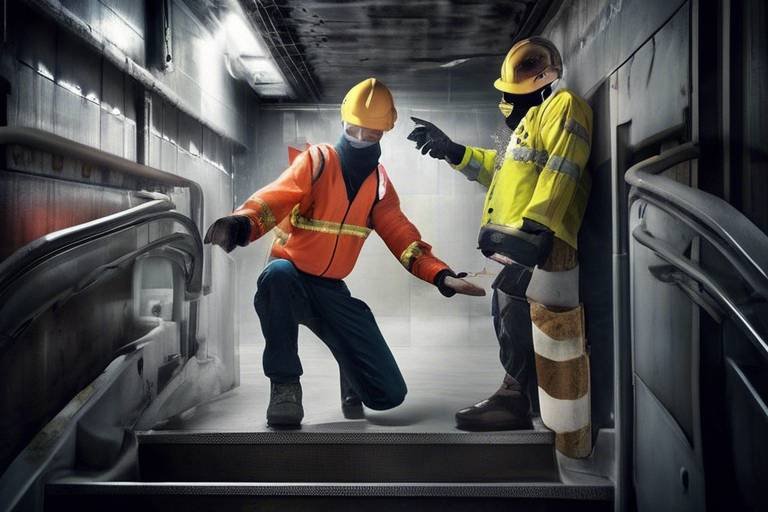Enhancing Safety through Behavior-Based Strategies
In today’s fast-paced work environments, ensuring safety is not just a priority; it’s a necessity. Organizations are constantly seeking innovative ways to enhance safety protocols, and one of the most effective approaches is through behavior-based strategies. These strategies focus on the actions of employees rather than merely the conditions of the workplace. By shifting the focus to behaviors, companies can create a culture where safety becomes a shared responsibility among all employees. Imagine a workplace where everyone is not only aware of safety practices but is actively participating in making their environment safer. This article dives deep into the importance of behavior-based safety (BBS), highlighting effective practices, training methods, and the vital role of leadership in fostering a culture of safety.
Understanding the significance of behavior-based safety (BBS) is essential for organizations seeking to minimize risks. BBS focuses on identifying and modifying unsafe behaviors to create a safer workplace for all employees. It’s not enough to simply have safety protocols in place; employees must also be aware of their actions and how these actions impact their safety and the safety of others. By recognizing that most accidents stem from unsafe behaviors rather than unsafe conditions, organizations can implement targeted interventions that effectively reduce incidents. Think of it like driving a car: it's not just about having seatbelts and airbags; it’s about the driver’s behavior behind the wheel that ultimately determines safety on the road.
Successful behavior-based safety programs incorporate several critical components, including observation, feedback, and reinforcement. These elements work together to promote safe practices and improve overall safety performance in the workplace. Each component plays a unique role in ensuring that safety becomes an integral part of the organizational culture. For instance, without effective observation techniques, it would be challenging to identify the behaviors that need modification. Likewise, feedback mechanisms are essential for reinforcing positive behaviors and correcting unsafe ones. Let's explore these components further.
Effective observation techniques are vital for identifying unsafe behaviors. By systematically observing employees, organizations can gather data to inform safety interventions and enhance awareness of safety practices. This is where the magic happens! The more we observe, the more we learn about the behaviors that lead to accidents. There are various methods of observation, including:
- Direct Observation: This involves watching employees as they perform tasks, providing immediate opportunities for feedback and correction. This hands-on approach helps reinforce safe behaviors in real-time.
- Peer Observations: Encouraging employees to observe each other’s behaviors fosters a sense of accountability and shared responsibility for safety among team members.
Feedback mechanisms are crucial for reinforcing safe behaviors and addressing unsafe practices. Providing constructive feedback helps employees understand the impact of their actions on safety. Think of feedback as the compass that guides employees toward safer practices. It’s essential that feedback is timely and specific, allowing employees to make adjustments immediately. Positive reinforcement can also motivate employees to maintain safe behaviors, creating a win-win situation for everyone involved.
Training and education are foundational elements of a successful behavior-based safety program. Empowering employees with knowledge and skills enhances their ability to recognize and modify unsafe behaviors. When employees are well-informed, they are more likely to take proactive measures to ensure their safety and the safety of their colleagues. This is where organizations can shine by investing in comprehensive training programs.
Workshops and seminars provide interactive learning experiences that engage employees in safety discussions. These sessions can cover various topics, from hazard recognition to effective communication strategies. Imagine a workshop where employees share their experiences and learn from each other—this not only builds camaraderie but also reinforces the importance of safety in a relatable way.
Implementing continuous learning opportunities, such as online courses and refresher training, ensures that employees remain informed about safety practices and can adapt to changes in their work environment. Just like how technology evolves, so should safety practices. Continuous education keeps safety at the forefront of employees' minds, making it a natural part of their daily routines.
Leadership plays a pivotal role in establishing and maintaining a strong safety culture. Leaders must model safe behaviors and demonstrate a commitment to safety at all levels of the organization. When leaders prioritize safety, it sends a powerful message to all employees that safety is everyone’s responsibility.
Leaders who prioritize safety and model safe behaviors inspire employees to do the same. Demonstrating a genuine commitment to safety fosters trust and encourages open communication about safety concerns. Employees are more likely to follow suit when they see their leaders actively participating in safety initiatives.
Encouraging employee involvement in safety initiatives empowers individuals to take ownership of their safety. Engaging employees in decision-making processes enhances their commitment to maintaining a safe work environment. It’s like planting a seed; when employees feel valued and included, they are more likely to nurture that seed into a thriving safety culture.
Q: What are behavior-based safety strategies?
A: Behavior-based safety strategies focus on identifying and modifying unsafe behaviors to create a safer workplace. They emphasize the importance of employee actions in maintaining safety.
Q: How can organizations implement BBS programs?
A: Organizations can implement BBS programs by incorporating observation techniques, feedback mechanisms, and comprehensive training programs that empower employees to recognize and modify unsafe behaviors.
Q: Why is leadership important in BBS?
A: Leadership is crucial in BBS as it sets the tone for the safety culture within an organization. Leaders who model safe behaviors and encourage employee involvement foster a stronger commitment to safety among staff.

The Importance of Behavior-Based Safety
Understanding the significance of behavior-based safety (BBS) is essential for organizations seeking to minimize risks and create a safer workplace. In a world where accidents can happen in the blink of an eye, focusing on the behaviors that lead to these incidents is not just smart; it's vital. Imagine a ship navigating through treacherous waters—each crew member's actions can either steer it safely to harbor or send it crashing against the rocks. Similarly, in any workplace, the actions of employees are the navigational tools that determine safety outcomes.
BBS emphasizes that most workplace accidents are a result of unsafe behaviors rather than unsafe conditions. By identifying and modifying these behaviors, organizations can significantly reduce the likelihood of incidents. It's like tuning a musical instrument; when each note is adjusted, the overall harmony improves, leading to a more productive and safe environment. The BBS approach encourages employees to take an active role in their safety, fostering a sense of ownership and accountability.
One of the most compelling reasons to implement a BBS program is its potential to enhance overall safety performance. Research has shown that organizations with effective BBS initiatives experience fewer accidents and injuries. This not only protects employees but also reduces costs associated with workplace injuries, such as medical expenses and lost productivity. Here are some key benefits of adopting behavior-based safety:
- Reduction in Workplace Accidents: By focusing on behaviors, organizations can proactively address the root causes of incidents.
- Enhanced Employee Engagement: Employees feel more involved and responsible for their safety and the safety of their colleagues.
- Improved Safety Culture: A commitment to BBS fosters a culture where safety is prioritized, leading to long-term behavioral change.
Moreover, the importance of BBS extends beyond immediate safety benefits. It cultivates a culture of continuous improvement, where employees are encouraged to learn from mistakes and share insights. This collaborative spirit not only enhances safety but also boosts morale and teamwork. When employees feel that their contributions matter, they are more likely to engage actively in safety practices.
In conclusion, the importance of behavior-based safety cannot be overstated. It is a proactive approach that empowers employees, reduces risks, and fosters a culture of safety that permeates every level of the organization. By investing in BBS strategies, companies are not just protecting their workforce; they are paving the way for a more resilient and productive future.
Q1: What is behavior-based safety?
A1: Behavior-based safety is a proactive approach that focuses on identifying and modifying unsafe behaviors to improve workplace safety.
Q2: How can organizations implement a BBS program?
A2: Organizations can implement a BBS program by conducting observations, providing feedback, and engaging employees in safety training and initiatives.
Q3: What are the benefits of behavior-based safety?
A3: Benefits include a reduction in workplace accidents, enhanced employee engagement, and an improved safety culture.

Key Components of BBS Programs
Successful behavior-based safety (BBS) programs are like the backbone of a healthy workplace, ensuring that safety is not just a policy but a way of life. At the heart of these programs lie several critical components that work synergistically to promote safe practices and improve overall safety performance. Understanding these components can significantly enhance an organization's ability to minimize risks and foster a culture of safety.
One of the primary components is observation. This involves systematically watching employees as they perform their tasks. By doing so, organizations can gather valuable data on unsafe behaviors and identify areas for improvement. The beauty of observation lies in its ability to provide real-time insights into how safety protocols are being followed. It’s like having a safety net that catches issues before they escalate into accidents.
Next, we have feedback, which is crucial for reinforcing safe behaviors and addressing unsafe practices. This component ensures that employees receive constructive feedback about their actions. Think of feedback as the compass that guides workers in the right direction, helping them understand the impact of their behaviors on safety. When feedback is delivered effectively, it can motivate employees to make positive changes in their work habits.
Another essential element of BBS programs is reinforcement. This involves recognizing and rewarding safe behaviors to encourage their repetition. By celebrating safety achievements, organizations can create an environment where employees feel valued and appreciated for their commitment to safety. Reinforcement can take various forms, such as verbal praise, safety awards, or even small incentives. It’s like giving a pat on the back that not only boosts morale but also fosters a sense of shared responsibility for safety.
To illustrate these key components further, let’s take a look at a simple table that summarizes their importance:
| Component | Description | Importance |
|---|---|---|
| Observation | Systematic watching of employees to identify unsafe behaviors. | Helps gather data for safety interventions. |
| Feedback | Constructive input provided to employees regarding their safety practices. | Guides employees towards safer behaviors. |
| Reinforcement | Recognition and rewards for safe behaviors. | Encourages repetition of safe practices. |
By integrating these components—observation, feedback, and reinforcement—organizations can create a comprehensive BBS program that not only identifies unsafe behaviors but also actively works to change them. It’s a continuous cycle of improvement that engages employees and fosters a proactive approach to safety. After all, when employees feel empowered and supported, they are more likely to embrace safety as a core value, leading to a safer and more productive workplace.
What is behavior-based safety?
Behavior-based safety (BBS) is a process that focuses on the behaviors of employees to enhance safety in the workplace. It aims to identify and modify unsafe behaviors to reduce risks and prevent accidents.
How does observation contribute to BBS?
Observation allows organizations to systematically monitor employee behaviors, providing data that can inform safety interventions and enhance awareness of safety practices.
Why is feedback important in BBS programs?
Feedback is crucial as it helps employees understand the impact of their actions on safety. Constructive feedback reinforces safe behaviors and addresses unsafe practices, guiding employees towards safer work habits.
What role does reinforcement play in promoting safety?
Reinforcement involves recognizing and rewarding safe behaviors, which encourages employees to continue practicing safety. It creates a positive environment where safety is valued and prioritized.

Observation Techniques
This article explores the importance of behavior-based strategies in enhancing safety within various environments, highlighting effective practices, training methods, and the role of leadership in fostering a culture of safety.
Understanding the significance of behavior-based safety (BBS) is essential for organizations seeking to minimize risks. BBS focuses on identifying and modifying unsafe behaviors to create a safer workplace for all employees.
Successful behavior-based safety programs incorporate several critical components, including observation, feedback, and reinforcement. These elements work together to promote safe practices and improve overall safety performance in the workplace.
Effective observation techniques are vital for identifying unsafe behaviors. By systematically observing employees, organizations can gather data to inform safety interventions and enhance awareness of safety practices. One of the most effective methods of observation is through direct observation, where safety personnel or supervisors closely watch employees as they perform their tasks. This method allows for immediate feedback, which can lead to real-time corrections and reinforcement of safe practices.
Another valuable approach is peer observations. This technique encourages employees to observe each other's behaviors, fostering a collaborative environment where safety becomes a shared responsibility. When employees feel accountable to one another, they are more likely to adhere to safety protocols. The synergy created through peer observations can significantly enhance the overall safety culture within an organization.
To illustrate the effectiveness of these observation techniques, consider the following table that highlights the differences:
| Observation Technique | Description | Benefits |
|---|---|---|
| Direct Observation | Watching employees perform tasks in real-time. | Immediate feedback and correction; reinforces safe behaviors. |
| Peer Observations | Employees observe each other’s behaviors. | Fosters accountability; encourages teamwork in safety. |
In conclusion, observation techniques are not just about watching; they are about understanding the nuances of behavior in a safety context. By employing both direct and peer observation methods, organizations can create a proactive safety environment that not only identifies risks but also empowers employees to take action. This dual approach can lead to a significant reduction in workplace accidents and an overall improvement in safety culture.
Feedback mechanisms are crucial for reinforcing safe behaviors and addressing unsafe practices. Providing constructive feedback helps employees understand the impact of their actions on safety.
Training and education are foundational elements of a successful behavior-based safety program. Empowering employees with knowledge and skills enhances their ability to recognize and modify unsafe behaviors.
Workshops and seminars provide interactive learning experiences that engage employees in safety discussions. These sessions can cover various topics, from hazard recognition to effective communication strategies.
Implementing continuous learning opportunities, such as online courses and refresher training, ensures that employees remain informed about safety practices and can adapt to changes in their work environment.
Leadership plays a pivotal role in establishing and maintaining a strong safety culture. Leaders must model safe behaviors and demonstrate a commitment to safety at all levels of the organization.
Leaders who prioritize safety and model safe behaviors inspire employees to do the same. Demonstrating a genuine commitment to safety fosters trust and encourages open communication about safety concerns.
Encouraging employee involvement in safety initiatives empowers individuals to take ownership of their safety. Engaging employees in decision-making processes enhances their commitment to maintaining a safe work environment.
Q: What is behavior-based safety?
A: Behavior-based safety (BBS) is a process that helps organizations understand how human behavior affects safety and aims to modify unsafe behaviors through observation and feedback.
Q: How can observation techniques improve workplace safety?
A: Observation techniques, such as direct and peer observations, help identify unsafe behaviors in real-time, allowing for immediate feedback and correction, ultimately fostering a safer work environment.
Q: Why is leadership important in safety culture?
A: Leadership is crucial because leaders set the tone for safety in an organization. By modeling safe behaviors and encouraging employee involvement, they can create a strong safety culture that prioritizes well-being.

Direct Observation
Direct observation is a fundamental technique in behavior-based safety (BBS) programs, serving as a powerful tool for identifying unsafe practices and promoting a culture of safety in the workplace. Imagine a coach watching their players during a game, keenly observing every move to provide immediate feedback and guidance. This is precisely how direct observation functions in a safety context. By watching employees as they perform their tasks, organizations can pinpoint areas where safety protocols may be overlooked or improperly executed.
One of the most significant advantages of direct observation is the opportunity for real-time feedback. When supervisors or safety personnel observe employees completing their work, they can immediately address unsafe behaviors or reinforce safe practices. This hands-on approach not only corrects unsafe actions on the spot but also helps to solidify safe behaviors in the minds of employees. For instance, if a worker is seen lifting a heavy object incorrectly, the observer can step in, provide guidance on proper lifting techniques, and ensure the employee understands the importance of using safe methods.
Moreover, direct observation fosters a sense of accountability. When employees know they are being observed, they are more likely to adhere to safety protocols. It creates an environment where everyone is aware of their actions and the potential consequences. This awareness can lead to a significant reduction in workplace accidents and injuries. However, it is crucial that the observation process is framed positively. Employees should view observers as allies rather than enforcers, which can be achieved through open communication and a supportive approach.
To implement effective direct observation strategies, organizations can consider the following steps:
- Define Clear Objectives: Establish what behaviors or practices need to be observed. This clarity helps observers focus their attention on key safety areas.
- Train Observers: Equip supervisors and safety personnel with the skills needed to observe effectively. Training should include how to provide constructive feedback and engage employees positively.
- Document Findings: Keep a record of observations to track progress and identify trends over time. This documentation can be invaluable for improving safety training and protocols.
- Encourage Employee Feedback: Create a two-way communication channel where employees can share their thoughts on the observation process. This feedback not only improves the program but also enhances employee buy-in.
In conclusion, direct observation is not just about watching employees; it’s about creating a dynamic interaction that encourages safety awareness and accountability. When implemented thoughtfully, this method can significantly enhance safety culture, making the workplace a safer environment for everyone. The key is to ensure that observation is viewed as a supportive tool rather than a punitive measure, fostering a sense of teamwork in the pursuit of safety.
Q: What is direct observation in behavior-based safety?
A: Direct observation involves watching employees perform their tasks to identify unsafe behaviors and provide immediate feedback to reinforce safe practices.
Q: How can direct observation improve workplace safety?
A: By providing real-time feedback and fostering accountability, direct observation helps employees adhere to safety protocols, reducing the risk of accidents and injuries.
Q: What should organizations focus on when implementing direct observation?
A: Organizations should define clear objectives, train observers, document findings, and encourage employee feedback to create an effective direct observation program.
Q: How can employees perceive direct observation positively?
A: By framing the observation process as a supportive initiative aimed at improving safety, organizations can help employees view observers as allies rather than enforcers.

Peer Observations
Peer observations are a powerful tool in the realm of behavior-based safety (BBS). They transform the workplace into a collaborative environment where employees actively participate in promoting safety. Imagine a scenario where each team member not only focuses on their own safety but also takes an interest in the safety of their colleagues. This approach fosters a culture of accountability, where everyone feels responsible for one another's well-being. By observing each other, employees can identify unsafe practices that might go unnoticed in traditional safety audits.
One of the key benefits of peer observations is the immediate feedback loop it creates. When employees observe their peers, they can provide real-time feedback, which is often more impactful than feedback received days or weeks later. This immediacy helps reinforce safe behaviors and correct unsafe actions on the spot. For instance, if an employee notices a colleague not wearing the appropriate personal protective equipment (PPE), they can gently remind them right away, thus preventing potential accidents.
Additionally, peer observations encourage open communication about safety. Employees may feel more comfortable discussing safety concerns with their peers than with supervisors, leading to a more transparent safety culture. This camaraderie can break down barriers and create a sense of teamwork, where safety becomes a shared goal. To implement an effective peer observation program, organizations can consider the following:
- Training Sessions: Provide employees with training on how to conduct observations and give constructive feedback.
- Observation Checklists: Develop checklists that guide employees on what to look for during observations.
- Recognition Programs: Acknowledge and reward employees who actively participate in peer observations, reinforcing the importance of this practice.
In conclusion, peer observations are not just about monitoring behaviors; they are about building a community that values safety. By empowering employees to take an active role in each other’s safety, organizations can create a more vigilant and proactive workforce. Such a culture not only minimizes risks but also enhances overall morale, as employees feel valued and involved in the safety process.
What are peer observations?
Peer observations involve employees observing each other's work behaviors to identify unsafe practices and reinforce safe behaviors. This collaborative approach promotes accountability and a shared commitment to safety.
How do peer observations improve workplace safety?
By encouraging employees to provide real-time feedback to one another, peer observations help correct unsafe behaviors immediately and foster open communication about safety concerns.
What training is needed for effective peer observations?
Employees should receive training on how to conduct observations, give constructive feedback, and use observation checklists to guide their assessments.
Can peer observations be part of a formal safety program?
Absolutely! Peer observations can be integrated into broader behavior-based safety programs to enhance overall safety performance and culture within the organization.

Feedback Mechanisms
Feedback mechanisms are crucial for reinforcing safe behaviors and addressing unsafe practices in the workplace. They serve as a bridge between observation and action, providing employees with the information they need to understand the impact of their behaviors on safety. Think of feedback as a compass; it guides individuals back on track when they veer away from safe practices. By creating a culture where feedback is not only welcomed but actively sought, organizations can significantly enhance their safety performance.
One effective way to implement feedback mechanisms is through regular safety meetings. These meetings can be designed to review observations from previous weeks, discuss common unsafe behaviors, and celebrate safe practices. During these sessions, employees can share their experiences and insights, fostering a sense of community around safety. Imagine a roundtable where everyone contributes to the discussion; this collaborative environment not only builds trust but also encourages open communication about safety concerns.
Furthermore, feedback should be constructive and focused on specific behaviors rather than personal attributes. For instance, instead of saying, "You are careless," a more effective approach would be, "I noticed that you didn’t wear your safety goggles while working on that task. Let’s make sure to use them next time." This method not only addresses the unsafe behavior but also shows that the feedback provider cares about the individual's well-being.
Another innovative approach to feedback is utilizing technology. Many organizations are now adopting mobile apps or online platforms where employees can report unsafe behaviors or commend safe practices in real-time. This immediate feedback loop allows for quick interventions and reinforces the importance of safety in daily operations. Imagine receiving a notification on your phone that highlights a recent safety success; it boosts morale and encourages others to follow suit.
In conclusion, effective feedback mechanisms are vital for any behavior-based safety program. They not only promote a culture of accountability but also empower employees to take charge of their safety. By emphasizing constructive feedback, fostering open communication, and leveraging technology, organizations can create an environment where safety is everyone’s responsibility.
- What is behavior-based safety? Behavior-based safety (BBS) focuses on identifying and modifying unsafe behaviors in the workplace to minimize risks and enhance safety.
- How can feedback improve safety? Feedback helps employees understand the impact of their actions on safety, reinforcing safe behaviors and addressing unsafe practices.
- Why is leadership important in safety culture? Leadership plays a crucial role in establishing a safety culture by modeling safe behaviors and encouraging employee involvement.
- What are some effective training methods for BBS? Workshops, seminars, and continuous learning opportunities are effective training methods that engage employees in safety discussions and practices.

Training and Education in BBS
When it comes to Behavior-Based Safety (BBS), training and education are not just optional; they are absolutely essential. Think of it this way: safety knowledge is like a toolkit. The more tools you have, the better equipped you are to tackle any situation that arises. Empowering employees with the right knowledge and skills enhances their ability to recognize and modify unsafe behaviors, ultimately fostering a safer workplace for everyone. This is where effective training programs come into play, acting as the foundation upon which a robust safety culture is built.
Workshops and seminars serve as fantastic platforms for interactive learning experiences. They are not just about sitting in a room and listening to a lecture; they engage employees in discussions about safety that are both informative and thought-provoking. For instance, imagine a workshop that covers topics from hazard recognition to effective communication strategies. Participants can share their experiences, ask questions, and learn from one another, creating a rich tapestry of knowledge that benefits the entire organization.
Moreover, the importance of continuous learning opportunities cannot be overstated. Just as our world is constantly evolving, so too are the safety challenges we face. Implementing ongoing training, such as online courses and refresher training sessions, ensures that employees remain informed about the latest safety practices and can adapt to changes in their work environment. This proactive approach not only keeps safety at the forefront of everyone’s mind but also instills a sense of confidence among employees, knowing they have the skills to handle potential hazards.
To illustrate the impact of training and education in BBS, consider the following table that outlines common training methods and their benefits:
| Training Method | Description | Benefits |
|---|---|---|
| Workshops | Interactive sessions that promote discussion and hands-on learning. | Enhances engagement and knowledge retention. |
| Online Courses | Self-paced learning modules accessible from anywhere. | Flexibility and convenience for busy employees. |
| Refresher Training | Periodic training sessions to reinforce safety knowledge. | Keeps safety practices top of mind and updates employees on new protocols. |
In conclusion, investing in training and education is a game-changer for any organization committed to enhancing its safety culture. By providing employees with the tools they need, organizations not only reduce the risk of accidents but also cultivate a workforce that is more aware, engaged, and proactive about safety. Remember, safety isn't just a priority; it should be a core value embedded in the fabric of the organization.
- What is Behavior-Based Safety (BBS)?
BBS is a safety management system that focuses on identifying and modifying unsafe behaviors to improve workplace safety. - Why is training important in BBS?
Training equips employees with the knowledge and skills necessary to recognize hazards and modify unsafe behaviors. - How can organizations implement continuous learning?
Organizations can offer online courses, refresher training, and regular workshops to ensure employees stay updated on safety practices. - What role does leadership play in BBS?
Leadership is crucial in modeling safe behaviors and fostering a culture of safety within the organization.

Workshops and Seminars
Workshops and seminars are more than just gatherings; they are dynamic learning experiences that can significantly enhance the effectiveness of behavior-based safety (BBS) programs. These interactive sessions create a platform for employees to engage in meaningful discussions about safety practices and challenges they face in their daily tasks. Imagine a room filled with employees who are not just passive listeners but active participants, sharing their insights and experiences. This collaborative environment fosters a sense of community and accountability, which is essential for cultivating a strong safety culture.
During workshops, employees can dive deep into various topics related to safety, such as hazard recognition, effective communication strategies, and the importance of teamwork in maintaining a safe workplace. These sessions often include hands-on activities, role-playing scenarios, and group discussions, allowing participants to apply what they learn in real-time. For instance, a workshop might involve a simulation where employees must identify potential hazards in a mock work environment, encouraging them to think critically about safety risks.
Seminars, on the other hand, typically feature expert speakers who share valuable insights and research findings on safety trends and best practices. These presentations can spark new ideas and motivate employees to adopt safer behaviors. The key is to ensure that these events are not one-off occurrences but part of a continuous learning strategy. By regularly scheduling workshops and seminars, organizations can keep safety at the forefront of employees' minds and promote a culture of ongoing improvement.
To maximize the impact of these educational sessions, it’s essential to collect feedback from participants. This feedback can help shape future workshops and seminars, ensuring they address the most relevant topics and concerns. Additionally, organizations can track the effectiveness of these programs by measuring changes in employee behavior and overall safety performance after the training.
In summary, workshops and seminars are critical components of a successful behavior-based safety program. They not only educate employees but also empower them to take an active role in safety initiatives, ultimately leading to a safer workplace for everyone.
- What are behavior-based safety workshops?
Behavior-based safety workshops are interactive training sessions designed to educate employees about identifying and modifying unsafe behaviors in the workplace. - How can seminars improve safety culture?
Seminars featuring expert speakers can provide valuable insights and motivate employees to adopt safer practices, enhancing the overall safety culture. - Why is feedback important after training sessions?
Feedback helps organizations tailor future training to meet employees' needs and assess the effectiveness of current safety initiatives.

Continuous Learning Opportunities
In today's fast-paced work environments, are not just beneficial; they are essential. Organizations that prioritize ongoing education empower their employees to stay ahead of the curve, especially when it comes to safety practices. Think of it as a never-ending journey where every step taken towards learning enhances the overall safety culture within the workplace.
One effective method to promote continuous learning is through online courses. These courses can be tailored to specific roles and responsibilities, ensuring that the training is relevant and applicable. For instance, an employee in a manufacturing plant might benefit from a course on machine safety, while someone in an office setting could focus on ergonomic practices. This personalized approach not only keeps employees engaged but also maximizes the impact of the training.
Additionally, organizations can implement refresher training sessions at regular intervals. These sessions serve as a great way to revisit key safety concepts and practices, reinforcing the importance of safety in daily operations. They can take the form of short workshops or even quick huddles at the start of a shift, where employees share insights or recent experiences related to safety. This not only keeps safety top-of-mind but also fosters a culture of open communication and shared learning.
Another innovative approach is to establish a mentorship program. Pairing seasoned employees with newer team members creates a dynamic learning environment. The experienced employees can share their knowledge and best practices, while newcomers can bring fresh perspectives and questions. This exchange of ideas can lead to improved safety practices and a stronger sense of community within the organization.
To illustrate the impact of continuous learning on safety culture, consider the following table:
| Learning Opportunity | Benefits |
|---|---|
| Online Courses | Flexible learning tailored to specific roles |
| Refresher Training | Reinforces key concepts and practices |
| Mentorship Programs | Encourages knowledge sharing and community building |
Ultimately, the goal of these continuous learning opportunities is to create a workforce that is not only knowledgeable but also proactive about safety. When employees feel equipped and confident in their ability to identify and mitigate risks, the entire organization benefits from a safer workplace.
- What are continuous learning opportunities?
Continuous learning opportunities refer to ongoing training and education initiatives that help employees improve their skills and knowledge over time.
- Why are they important for safety?
They are crucial for maintaining awareness of safety practices and adapting to new hazards, ensuring that employees are always prepared to handle risks effectively.
- How can organizations implement these opportunities?
Organizations can implement them through online courses, refresher training sessions, and mentorship programs that encourage knowledge sharing.

The Role of Leadership in Safety Culture
Leadership is the backbone of any successful safety culture within an organization. When leaders prioritize safety, it sends a powerful message that resonates throughout the entire workforce. Imagine a ship navigating through stormy seas; the captain's actions and decisions are crucial for steering the ship safely to harbor. Similarly, leaders in a workplace must steer their teams toward a culture of safety, ensuring that every employee feels valued and protected.
One of the most effective ways leaders can influence safety culture is by leading by example. When leaders consistently demonstrate safe behaviors, it sets a precedent for employees to follow. For instance, if a manager wears personal protective equipment (PPE) and adheres to safety protocols, it encourages employees to do the same. This kind of modeling fosters a sense of trust, as employees see that their leaders are genuinely committed to their well-being.
Moreover, effective communication is essential in fostering a safety culture. Leaders should create an environment where employees feel comfortable voicing their concerns about safety issues without fear of retribution. This open line of communication can be likened to a safety net; it catches potential hazards before they escalate into serious incidents. Regular safety meetings, feedback sessions, and anonymous reporting systems can help facilitate this communication.
Another critical aspect is encouraging employee involvement. When employees are actively engaged in safety initiatives, it empowers them to take ownership of their safety and that of their colleagues. This can be achieved through:
- Involving employees in safety committees
- Encouraging participation in safety audits
- Soliciting feedback on safety policies and practices
By involving employees in these processes, leaders not only enhance the safety culture but also foster a sense of community and shared responsibility. It’s like planting seeds in a garden; when everyone contributes to nurturing the plants, the garden flourishes.
To further illustrate the role of leadership in safety culture, consider the following table, which highlights key leadership actions and their impact on safety:
| Leadership Action | Impact on Safety Culture |
|---|---|
| Modeling Safe Behaviors | Sets a standard for employees to follow |
| Open Communication | Encourages reporting of safety concerns |
| Employee Involvement | Empowers staff and builds accountability |
| Regular Training | Keeps safety knowledge fresh and relevant |
In summary, the role of leadership in cultivating a strong safety culture cannot be overstated. By leading by example, fostering open communication, and encouraging employee involvement, leaders can create an environment where safety is a shared value. This not only reduces the risk of accidents but also enhances employee morale and productivity. After all, a safe workplace is a happy workplace, and that’s something every organization should strive for.
1. What is the role of leadership in promoting safety culture?
Leadership is crucial in setting the tone for safety culture. Leaders must model safe behaviors, encourage open communication, and involve employees in safety initiatives to foster a culture of safety.
2. How can leaders effectively communicate safety practices?
Leaders can effectively communicate safety practices through regular safety meetings, feedback sessions, and creating an open environment where employees feel comfortable voicing concerns.
3. Why is employee involvement important in safety culture?
Employee involvement is vital as it empowers individuals to take ownership of their safety, leading to a more engaged workforce and a stronger safety culture overall.
4. What are some effective strategies for training employees on safety?
Effective strategies include interactive workshops, continuous learning opportunities, and refresher courses that keep safety knowledge relevant and engaging.

Leading by Example
When it comes to fostering a culture of safety within an organization, nothing speaks louder than . Leaders who prioritize safety and consistently model safe behaviors create an environment where employees feel empowered to do the same. Imagine a ship navigating through stormy seas; the captain must not only steer the vessel but also ensure that the crew is well-prepared and vigilant. In a workplace, leaders are akin to that captain, guiding their teams through the unpredictable waters of daily operations.
By demonstrating a genuine commitment to safety, leaders build trust among their employees. This trust is crucial because it encourages open communication about safety concerns. When employees see their leaders taking safety seriously—wearing protective gear, adhering to safety protocols, and actively participating in safety training—they are more likely to follow suit. It’s a simple yet powerful principle: actions speak louder than words.
Moreover, leading by example can significantly influence the overall safety performance of an organization. When leaders engage in safe practices and openly discuss the importance of safety, it sets a tone that resonates throughout the entire team. Employees are more inclined to embrace safety initiatives when they see their leaders actively participating in them. For instance, a manager who regularly conducts safety audits not only identifies potential hazards but also demonstrates the importance of vigilance in maintaining a safe workplace.
To further illustrate the impact of leadership on safety culture, consider the following table that outlines the behaviors of effective leaders compared to those who do not prioritize safety:
| Effective Leaders | Leaders Lacking Safety Focus |
|---|---|
| Consistently follow safety protocols | Often overlook safety measures |
| Engage employees in safety discussions | Avoid conversations about safety |
| Provide resources for safety training | Neglect training opportunities |
| Recognize and reward safe behaviors | Fail to acknowledge safety achievements |
It's essential for leaders to not only talk the talk but also walk the walk. This means actively participating in safety drills, providing constructive feedback during safety observations, and recognizing employees who demonstrate safe practices. When leaders are visibly engaged, it creates a ripple effect, inspiring employees to take ownership of their safety and that of their colleagues.
In conclusion, leading by example is a critical component in establishing a robust safety culture. Leaders must embody the principles of safety they wish to instill in their teams, creating an environment where safety is not just a priority but a shared value. By doing so, they not only enhance workplace safety but also cultivate a culture of accountability and trust that benefits everyone involved.
- What is the role of leadership in safety culture?
Leadership is crucial in establishing and maintaining a safety culture by modeling safe behaviors and encouraging employee involvement. - How can leaders effectively demonstrate their commitment to safety?
Leaders can demonstrate commitment by following safety protocols, participating in training, and recognizing safe behaviors among employees. - What impact does leading by example have on employees?
When leaders lead by example, employees are more likely to feel empowered to prioritize safety, fostering a culture of accountability.

Encouraging Employee Involvement
Encouraging employee involvement in safety initiatives is not just a checkbox on a to-do list; it’s an essential strategy for cultivating a robust safety culture within any organization. Imagine a workplace where every employee feels a sense of ownership over their safety and that of their colleagues. This sense of responsibility can lead to a significant reduction in accidents and injuries. But how do we get there? The answer lies in actively engaging employees in safety discussions and decision-making processes.
One effective way to encourage involvement is by creating cross-functional safety teams. These teams, composed of employees from various departments, can bring diverse perspectives and ideas to the table. When individuals feel that their voices are heard and valued, they are more likely to contribute actively. Additionally, these teams can conduct regular safety audits and assessments, allowing employees to take a hands-on approach to identifying potential hazards.
Moreover, implementing a suggestion program can empower employees to share their insights and recommendations for improving safety practices. This program could include a simple online portal or a physical suggestion box where employees can submit their ideas anonymously. Recognizing and rewarding employees whose suggestions lead to meaningful safety improvements not only boosts morale but also fosters a culture of continuous improvement.
Furthermore, consider organizing safety workshops where employees can collaboratively discuss safety challenges and brainstorm solutions. These workshops can serve as a platform for sharing experiences and learning from one another. When employees see that their input can lead to real changes, they become more invested in the safety culture of the organization.
It’s also crucial to communicate the importance of safety in everyday operations. Leaders should regularly share updates on safety performance and highlight the contributions of employees in improving safety standards. This transparency reinforces the idea that safety is a collective responsibility and that every individual plays a crucial role in achieving a safer workplace.
In summary, encouraging employee involvement in safety initiatives is about creating an environment where everyone feels empowered to contribute. By fostering open communication, implementing suggestion programs, and organizing collaborative workshops, organizations can cultivate a culture where safety is prioritized, and everyone is actively engaged in the process. Remember, when employees are involved, they are not just following rules—they are part of a team working towards a common goal: a safer workplace for all.
- Why is employee involvement important in safety initiatives? Employee involvement fosters a sense of ownership and accountability, leading to a safer workplace.
- How can organizations encourage employee participation? By creating cross-functional teams, implementing suggestion programs, and organizing safety workshops.
- What role do leaders play in encouraging involvement? Leaders must model safe behaviors and promote open communication about safety concerns.
Frequently Asked Questions
- What is behavior-based safety (BBS)?
Behavior-based safety (BBS) is a proactive approach that focuses on identifying and modifying unsafe behaviors in the workplace. By understanding how behaviors impact safety, organizations can create a safer environment for all employees.
- Why is BBS important for organizations?
BBS is crucial because it helps minimize risks and injuries by promoting safe practices. It fosters a culture where safety becomes a shared responsibility, ultimately leading to improved overall safety performance.
- What are the key components of a successful BBS program?
A successful BBS program includes observation, feedback, and reinforcement. These elements work together to identify unsafe behaviors, provide constructive feedback, and encourage safe practices among employees.
- What are observation techniques in BBS?
Observation techniques involve systematically watching employees to identify unsafe behaviors. This can include direct observation, where supervisors watch employees perform tasks, and peer observations, where colleagues observe each other’s behaviors.
- How does feedback contribute to BBS?
Feedback is essential in BBS as it reinforces safe behaviors and addresses unsafe practices. Constructive feedback helps employees understand the consequences of their actions and encourages them to make safer choices.
- What role does training play in BBS?
Training is foundational in BBS programs. It equips employees with the knowledge and skills they need to recognize and modify unsafe behaviors. Workshops, seminars, and continuous learning opportunities are vital for effective training.
- How can leadership impact safety culture?
Leadership plays a critical role in shaping safety culture. Leaders who model safe behaviors and prioritize safety inspire employees to follow suit, fostering an environment of trust and open communication regarding safety concerns.
- What is the importance of employee involvement in safety initiatives?
Encouraging employee involvement empowers individuals to take ownership of their safety. When employees participate in safety initiatives and decision-making, it enhances their commitment to maintaining a safe work environment.



















